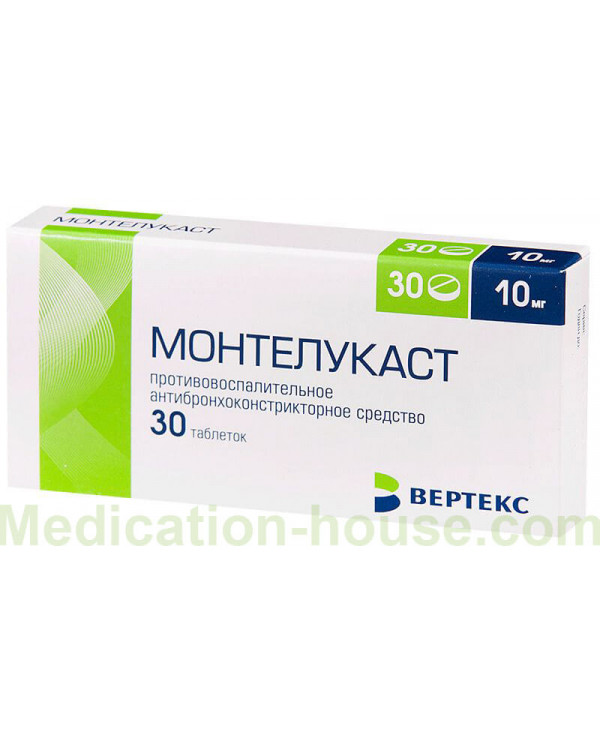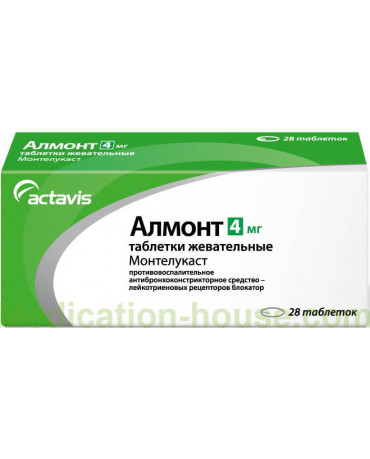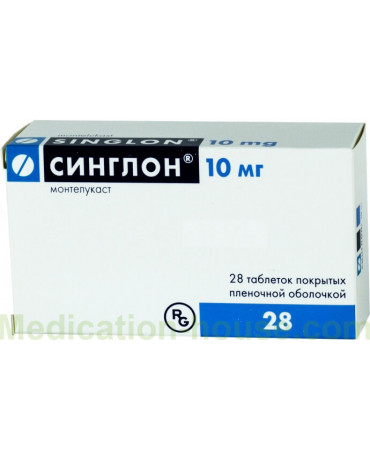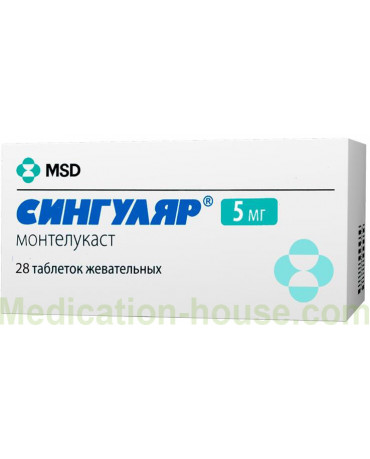Montelukast is an anti-inflammatory anti-bronchoconstrictor drug, a leukotriene receptor blocker.
Release form and composition
film-coated tablets: depending on the manufacturer, they can be round, biconvex, with a yellow film coating and a white or almost white core, or square with rounded corners, engraved “I” on one side and “114” on the other, a film membrane of pale orange with a brownish tint and a white or almost white core (in blisters for 10, 14, 15, 20, 28 or 30 tablets, in a cardboard box 1, 3 or 6 packs of 10 tablets, 1 or 2 packs 14 or 30 tablets, 1, 2 or 4 packs of 15 tablets, 3 packs Application of 20 tablets 1 tablet package 28; 10, 14 or 60 tablets in a jar, a carton bank 1);
Composition of 1 film-coated tablet:
active substance: montelukast sodium - 10.4 mg (in terms of montelukast - 10 mg);
auxiliary components: lactose monohydrate, microcrystalline cellulose, croscarmellose sodium, magnesium stearate;
film membrane (one of the options): I - hypromellose, hyprolose, talc, titanium dioxide, iron oxide yellow; II - a dry mixture for film coating, including hypromellose, hyprolose, talc, titanium dioxide, yellow iron oxide; III - Opadry yellow 20A520007 (hypromellose, hyprolose, carnauba wax, titanium dioxide, dyes iron oxide yellow and iron oxide red).
Pharmacodynamics
Montelukast, when taken orally, significantly improves inflammation in patients with bronchial asthma. Biochemical and pharmacological analysis showed that it binds to CysLT1 receptors with high selectivity and chemical affinity. The drug inhibits the physiological effect of the cysteinyl leukotrienes LTC4, LTD4, LTE4 by binding to CysLT1 receptors, without exerting a stimulating effect on these receptors.
Montelukast in a dose of 5 mg relieves bronchospasm caused by inhalation of LTD4 cysteinyl-leukotriene in patients with bronchial asthma. The use of the drug leads to bronchodilation within 2 hours after administration, and can also complement bronchodilation caused by β2-adrenergic agonists.
Taking more than 10 mg of montelukast per day is not advisable, as this will not increase its effectiveness.
Pharmacokinetics
After oral administration, montelukast is almost completely absorbed for a short time. When adults take 10 mg of the drug (1 film-coated tablet), the maximum plasma concentration is reached within 3 hours, and when taken on an empty stomach, 5 mg of the drug (1 chewable tablet) within 2 hours. The average bioavailability when taking film-coated tablets is 64%, and that of chewing tablets is 73%.
Communication with plasma proteins - 99%. The volume of distribution in a state of equilibrium concentration is 8–11 liters. The drug is actively metabolized. Its metabolism involves isoenzymes of cytochrome P450 - CYP 3A4, CYP 2A6, CYP 2C8 and CYP 2C9.
Montelukast plasma clearance in healthy patients is 45 ml / min. It is excreted mainly through the intestines (86%). The half-life is 2.7–5.5 hours. When taking the drug at 10 mg per day, its cumulation remains moderate (about 14%).
The pharmacokinetics of the drug is not affected by the gender, age and race of the patient.
In patients with mild to moderate liver failure, the metabolism of the drug is somewhat slowed down, and the area under the concentration-time curve (AUC) is increased by about 41% with a single dose of 10 mg of montelukast. There are no data on the pharmacokinetics of montelukast in patients with severe hepatic insufficiency.
Indications for use
long-term therapy of bronchial asthma and prevention of its day and night symptoms;
treatment of bronchial asthma with increased sensitivity to acetylsalicylic acid;
relief of daytime and nighttime symptoms of rhinitis (allergic and persistent);
prevention of bronchospasm caused by physical exertion.
Contraindications
lactase deficiency, lactose intolerance, glucose-galactose malabsorption (for film-coated tablets);
phenylketonuria (for chewable tablets);
age up to 6 years (for chewable tablets), age up to 15 years (for film-coated tablets);
increased sensitivity to the components of the drug.
Instructions for use: method and dosage
Montelukast is taken orally, regardless of food intake. With bronchial asthma (in combination with or without allergic rhinitis), the drug is recommended to be taken in the evening, and with allergic rhinitis, at any time.
Film-coated tablets are intended for adolescents over 15 years of age and adults. The recommended dosage is 1 tablet 1 time per day.
Recommendations for the use of chewable tablets:
children 6-14 years: 1 tablet 1 time per day;
adolescents over 15 years old and adults: 2 tablets 1 time per day.
The effect of the drug in patients with bronchial asthma begins to appear during the first day of its administration. It is recommended to continue therapy while achieving symptom control, as well as during an exacerbation of the disease.
Side effects
nervous system: dizziness, headache, drowsiness, paresthesia, hypesthesia, cramps;
cardiovascular system: heart palpitations;
respiratory system, chest and mediastinal organs: nosebleeds, pulmonary eosinophilia;
psyche: agitation, aggression, hostility, anxiety, depression, impaired attention, disorientation, insomnia, pathological dreams, hallucinations, memory impairments, irritability, anxiety, tremor, somnambulism, tic, suicidal thoughts and behavior;
gastrointestinal tract: nausea, vomiting, dyspepsia, pancreatitis, abdominal pain, thirst;
liver and biliary tract: increased activity of alanine aminotransferase and aspartate aminotransferase, hepatitis;
kidneys and urinary tract: enuresis (in children);
musculoskeletal and connective tissue: myalgia (including muscle cramps), arthralgia;
blood and lymphatic system: bleeding tendency, thrombocytopenia;
skin and subcutaneous tissues: rash, itching, urticaria, tendency to hematomas, erythema nodosum or multiform, angioedema;
immune system: allergic reactions, including anaphylaxis, eosinophilic infiltration of the liver.
In addition, the development of an upper tract infection, weakness, fatigue, swelling and pyrexia are possible.
Usually, side effects are fairly easy and do not require discontinuation of the drug.
Overdose
Symptoms of an overdose of Montelukast (when taken at least 1000 mg per day): thirst, drowsiness, psychomotor agitation, vomiting, abdominal pain, mydriasis, headaches.
Symptomatic therapy recommended.
Special instructions
The appointment of Montelukast in acute attacks of bronchial asthma is not recommended, since its effectiveness in such cases has not been established. It is always necessary to have emergency equipment with you when you have asthma attacks (inhaled short-acting β2-agonists). During the period of exacerbation, you should continue to take the drug.
For patients with an allergy to acetylsalicylic acid and other non-steroidal anti-inflammatory drugs, it is undesirable to take these drugs against the background of Montelukast therapy, since the drug is not able to completely prevent bronchoconstriction caused by their action.
Patients, as well as their parents and guardians, should take into account the possibility of developing neuropsychiatric symptoms that sometimes occur during Montelukast therapy, although a causal relationship between its use and these undesirable effects has not been established. If such symptoms appear, they should be reported to the attending physician.
Rarely, eosinophilia, worsening pulmonary symptoms, rash, neuropathy, or cardiac complications, sometimes diagnosed as systemic eosinophilic vasculitis, have been reported with anti-asthma medications. Sometimes these symptoms occurred with a dose reduction or withdrawal of oral corticosteroids. In this regard, patients taking Montelukast should be monitored accordingly.
Film-coated tablets contain lactose monohydrate.
Chewable tablets contain aspartame in an amount equivalent to 0.842 mg of phenylalanine.
Influence on the ability to drive vehicles and complex mechanisms
In connection with the possible development of undesirable effects such as dizziness and drowsiness, caution should be exercised during Montelukast therapy when driving motor vehicles and other complex mechanisms requiring the speed of psychomotor reactions.
Pregnancy and lactation
With post-registration use of Montelukast by pregnant women, cases of development of congenital limb defects in newborns have been noted. A causal relationship between this phenomenon and Montelukast administration has not been established; it was usually taken in combination with other drugs for the treatment of bronchial asthma.
The use of the drug during pregnancy / lactation is allowed only if the expected benefit to the mother outweighs the possible risk to the fetus / child.
Use in childhood
Montelukast chewable tablets are approved for use by children from 6 years. Adolescents over 15 years of age are shown the usual adult dose.
With impaired renal function
According to the instructions, Montelukast is not excreted by the kidneys, and therefore dose adjustment for patients with impaired renal function is not required.
With impaired liver function
Patients with mild to moderate severity of liver failure do not need dose adjustment.
Use in old age
No dose adjustment is required for the elderly.
Drug interaction
prednisone, theophylline, prednisolone, oral contraceptives, terfenadine, digoxin, warfarin: joint use is allowed;
phenobarbital: AUC of montelukast is reduced by 40%, dose adjustment is not required;
paclitaxel, rosiglitazone, repaglinide and other drugs metabolized with the participation of the CYP 2C8 isoenzyme: montelukast has no effect on them;
gemfibrozil: increases the effect of systemic exposure to montelukast by 4.4 times; this effect has no clinical significance, dose adjustment of montelukast is not required;
trimethoprim and other known inhibitors of the CYP 2C8 isoenzyme: no clinically significant interactions have been observed, dose adjustment of montelukast is not required.
Montelukast can be used as part of combination therapy with bronchodilators and inhaled glucocorticosteroids. After achieving a lasting effect, a gradual decrease in their dose is allowed. In some cases, even the complete cancellation of inhaled glucocorticosteroids is possible, but they should not be abruptly replaced by Montelukast.
Terms and conditions of storage
Keep away from light at a temperature not exceeding 25 ° C. Keep out of the reach of children.
Shelf life - 3 years (for film-coated tablets), 2 years (for chewable tablets).
Reviews
Reviews about Montelukast testify to its effectiveness in the fight against allergic cough and rhinitis. In addition, among the pros note the pleasant taste of chewable tablets that children like, as well as a lower price than their counterparts. The disadvantage is the risk of side effects, as well as the lack of instant action of the drug.
Terms of sell
You don't need a prescription to buy Montelukast.




